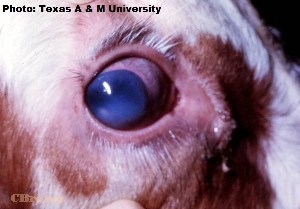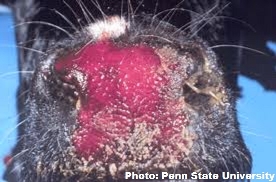| Malignant
Catarrhal Fever |
 |
|
| |
| Causative Agent |
-
Malignant catarrhal fever (MCF) is an infectious, viral disease of many
ruminants,
including bison (Bison bison).
It occurs worldwide and is generally sporadic, although herd
outbreaks have been reported.
-
In North America, MCF is caused by ovine herpes virus-2, which infects
sheep with no ill effects and spreads to susceptible species like
bison.
|
| Images |
|
Click on
images to enlarge. |
 |
 |
|
Domestic cattle showing
signs of MCF. |
|
| Distribution |
|
Geographic: |
-
MCF has been documented worldwide in both wild and domestic
ruminants.
-
MCF has not been detected in wild
ruminants in BC.
|
|
Seasonality: |
-
MCF can occur any time throughout the year.
|
|
| Hosts and Transmission |
-
MCF has been documented in wild
ruminants globally.
-
In Saskatchewan, MCF has been found to have been transferred from sheep
to free-ranging moose (Alces
alces).
-
Transmission of MCF had been shown to occur from animal to animal within
the same species as well as from mother to young during
pregnancy or birth.
|
|
| Signs and Symptoms |
-
Gross pathological
changes are generally widespread and may involve most organ systems.
The severity of this disease does vary, and signs include:
-
severe
inflammation of the oral and nasal
mucosa;
-
bleeding and
inflammation of stomach and small intestine
(hemorrhagic gastroenteritis);
-
fever;
-
diarrhea;
-
redness of oral and
nasal
mucosa with accompanying discharges;
-
encrustation of the
muzzle and nasal area, causing obstruction of the nostrils and
shortness of breath, open-mouthed breathing, and drooling;
-
skin
lesions
occasionally are seen, and horn as well as hooves wall may be
loosened or sloughed;
-
clouding or
ulceration of the eyes.
|
| Meat Edible? |
-
Not suitable for human
consumption.
|
| Human Health Concerns and
Risk Reduction |
-
The CFIA has recognized Bovine Malignant Catarrhal Fever as an
annually notifiable disease, which in general are diseases that are present in Canada, but are
not classified as reportable or immediately notifiable.
-
There is no
zoonotic potential for this disease.
|
| Samples for Diagnosis |
-
A set of affected tissues should be collected in a 10% solution of
formalin for microscopic examination.
-
Blood samples also can be submitted to diagnose this disease.
|
| Further Reading |
|
|
|
|


